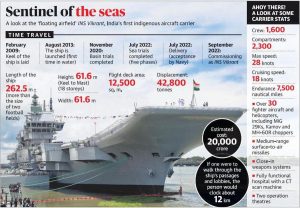07 Sep 2022 INS Vikrant and Maritime Strategy
GS Paper 3: Security Challenges and their Management in Border Areas – Linkages of Organized Crime with Terrorism.
About INS Vikrant:
- INS Vikrant is largest and most complex indigenously built warship of India.
- It is developed by the Navy’s warship design bureau and constructed by the Cochin Shipyard Limited (CSL).
- With a displacement of 43,000 tonnes, the ship boasts an endurance of about 7,500 nautical miles and a cruising speed of 18 knots (significant for its size and tonnage).
- The ship’s integral fleet of MiG 29K aircraft, Kamov 31 early warning and MH-60R multi-role helicopters, as also state-of-the-art shipboard offence and defence systems, surveillance and fire-control radars, make it a formidable warfighting platform.

Why is INS Vikrant key to India’s maritime strategy?
- An aircraft carrier is an instrument of utilitarian value as well as beating heart that provides all naval effort with its essential vigor.
- Aircraft carriers like INS Vikrant provide thorough and emphatic access to littoral spaces in war as well as in peace.
- An aircraft carrier has the critical ability to alter the psychological balance in the littorals. As, it will ensure effective sea command, through continuous and visible maritime presence that influences the cost-benefit calculus of the enemy commanders.
- It helps in “power projection” that is a crucial component of peacetime maritime strategy, and an embodiment of a nation’s strategic capability and political intent. A navy’s ability to project military power far beyond the home country is a metric of national influence and regional relevance.
- Utility in advancing national objectives: Demonstrative impact of an aircraft carrier sailing through foreign waters that cannot be replicated by a submarine or a destroyer.
- It will help in enhancing Soft power diplomacy through soft-power outreach such as hospital ships, humanitarian assistance and disaster relief platforms, survey vessels, etc and peacetime diplomacy.
- INS Vikrant will help in enhancing Indian strategic capacity in the Indian Ocean region as it will deter adversaries and mark its presence in the near-seas.
- It will check “far-seas” strategy and ambition of the People’s Liberation Army Navy (PLAN) and the role that China’s aircraft carriers are likely to play in the Pacific and the Indian Oceans.
What are various skepticism about the relevance of aircraft carriers in the contemporary world?
- Low Cost-Benefit ratio: Building aircraft carriers requires enormous cost and there is little point in spending billions for a carrier strike force to protect the Bay of Bengal or the Arabian Sea, when near-seas defence can be easily ensured from airbases on India’s island territories.
- Susceptible to enemy attack: Aircraft carriers are considered as logistically unviable, and highly vulnerable to new hypersonic weapons and disruptive technologies.
- Chances of aircraft carriers virtually sitting duck in a conflict scenario: As they are defenceless against modern-day underwater attacks, long-range strategic airpower and ballistic missiles; a virtual sitting duck in a conflict scenario.
- Symbolic value of Aircraft operating warships make them prized targets in wartime.
- Vulnerability of aircraft carriers: Generally such ships are targets of heavy ordance as for navies locked in combat, the destruction of the opponent’s aircraft carrier is a priority mission.
Conclusion: Deployment of maritime power needs to be anchored in the logic of geopolitics and long-term state interests, and not on contingent assessments of imminent needs.
Source:-Indian Express
Source Link:
- Indian Express:-https://bit.ly/3xeV94r ; Author Name:-Abhijit Singh
Yojna IAS Daily current affairs eng med 7th Sep


No Comments